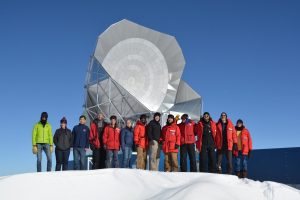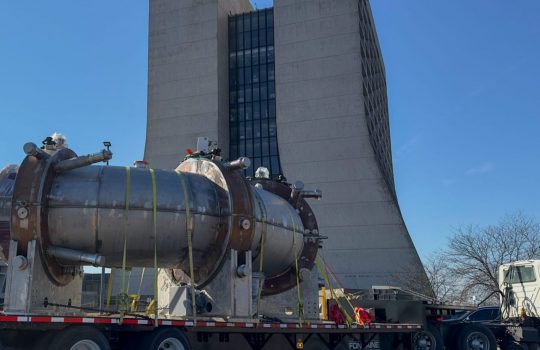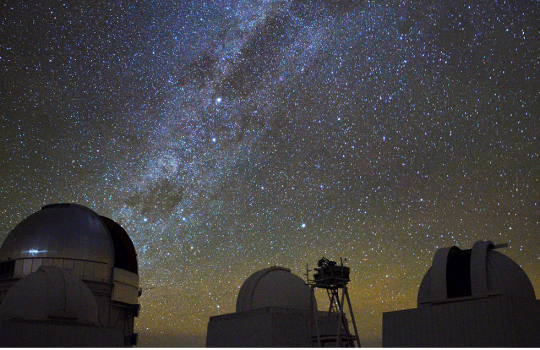South Pole Telescope contributes to historic observations of supermassive black hole at heart of distant galaxy
Below is a press release from the University of Chicago announcing an exciting new result from the Event Horizon Telescope (EHT), an array of radio telescopes located around the world. Included in that array is the South Pole Telescope (SPT), which is operated by a collaboration of more than 80 scientists and engineers from a group of universities and U.S. Department of Energy national laboratories, including three institutions in the Chicago area.
These research organizations — the University of Chicago and the U.S. Department of Energy’s Fermi National Accelerator Laboratory and Argonne National Laboratory — worked together to build a new, ultrasensitive camera for the telescope, called SPT-3G, which contains 16,000 superconducting detectors. Exploiting the technical capability and expertise of its Silicon Detector Facility, Fermilab led the assembly of the detector modules and their integration into the SPT-3G camera, which was designed by Bradford Benson of Fermilab and the University of Chicago. On EHT, Fermilab scientists helped to design the EHT receiver interface and installation on the SPT and have supported EHT observations through their leading roles on SPT-3G survey and SPT telescope operations. Fermilab’s work on the South Pole Telescope is funded by the U.S. Department of Energy Office of Science.

This is the first image ever taken of a black hole. This black hole resides at the center of Messier 87, a massive galaxy in the nearby Virgo galaxy cluster. Image: Event Horizon Telescope
The Event Horizon Telescope — a planet-scale array of eight ground-based radio telescopes forged through international collaboration — was designed to capture images of a black hole. On April 10, in coordinated news conferences across the globe, researchers revealed that they have succeeded, unveiling the first direct visual evidence of a supermassive black hole and its shadow.
This breakthrough was announced April 10 in a series of six papers published in a special issue of The Astrophysical Journal Letters. The image reveals the black hole at the center of Messier 87, a massive galaxy in the nearby Virgo galaxy cluster. This black hole sits 55 million light-years from Earth and has a mass 6.5 billion times that of the sun.
The EHT links telescopes around the globe, including the University of Chicago-run South Pole Telescope, to form an unprecedented Earth-sized “virtual telescope” with unprecedented sensitivity and resolution. The EHT is the result of years of international collaboration, and offers scientists a new way to study the most extreme objects in the universe predicted by Einstein’s theory of general relativity.

The South Pole Telescope is one of eight ground-based radio telescopes that make up the Event Horizon Telescope array. Photo: Jason Gallicchio, University of Chicago
“We have taken the first picture of a black hole — a one-way door out of our universe,” said EHT project director Sheperd S. Doeleman of the Center for Astrophysics | Harvard & Smithsonian. “This is an extraordinary scientific feat accomplished by a team of more than 200 researchers.”
Black holes are extraordinary cosmic objects with enormous masses but extremely compact sizes. The presence of these objects affects their environment in extreme ways, warping space-time and superheating any surrounding material.
“If immersed in a bright region, like a disc of glowing gas, we expect a black hole to create a dark region similar to a shadow — something predicted by Einstein’s general relativity that we’ve never seen before,” explained chair of the EHT Science Council Heino Falcke of Radboud University in the Netherlands. “This shadow, caused by the gravitational bending and capture of light by the event horizon, reveals a lot about the nature of these fascinating objects and has allowed us to measure the enormous mass of M87’s black hole.”
Multiple calibration and imaging methods have revealed a ring-like structure with a dark central region — the black hole’s shadow — that persisted over multiple independent EHT observations.
The EHT observations use a technique called very-long-baseline interferometry, which synchronizes eight telescope facilities around the world and exploits the rotation of our planet to form one huge, Earth-size telescope observing at a wavelength of 1.3 millimeters. This technique allows the EHT to achieve an angular resolution of 20 microarcseconds—enough to read a newspaper in New York from a sidewalk cafe in Paris.
One of these telescopes was the South Pole Telescope, one of the most sensitive instruments in the world built to search for the oldest light in the universe. Operated by an international collaboration led by the University of Chicago, the South Pole Telescope helped calibrate the data from all telescopes and is key to expanding the EHT’s reach around the globe.
“The South Pole Telescope’s location at the southernmost point of the Earth makes it an important component of the global EHT network,” said John Carlstrom, who directs the telescope. “Although M87 is not visible from the South Pole, it is a crucial player in observing other black holes, such as the massive one at the center of our own galaxy.”
Creating the EHT was a formidable challenge that required upgrading and connecting a worldwide network of eight pre-existing telescopes deployed at a variety of challenging high-altitude sites. These locations included volcanoes in Hawaii and Mexico, mountains in Arizona and the Spanish Sierra Nevada, the Chilean Atacama Desert, and Antarctica.
Besides the South Pole Telescope, the other contributing telescopes were ALMA, APEX, the IRAM 30-meter telescope, the James Clerk Maxwell Telescope, the Large Millimeter Telescope Alfonso Serrano, the Submillimeter Array, and the Submillimeter Telescope. Petabytes of raw data from the telescopes were combined by highly specialized supercomputers hosted by the Max Planck Institute for Radio Astronomy and MIT Haystack Observatory.

The South Pole Telescope team, led by the University of Chicago, Fermilab and Argonne National Laboratory. Photo courtesy of Brad Benson
“Once we were sure we had imaged the shadow, we could compare our observations to extensive computer models that include the physics of warped space, superheated matter and strong magnetic fields. Many of the features of the observed image match our theoretical understanding surprisingly well,” said Paul T.P. Ho, EHT board member and director of the East Asian Observatory. “This makes us confident about the interpretation of our observations, including our estimation of the black hole’s mass.”
The construction of the EHT and the observations represent the culmination of decades of observational, technical and theoretical work. Thirteen partner institutions worked together to create the EHT, using both pre-existing infrastructure and support from a variety of agencies. Key funding was provided by the National Science Foundation, the EU’s European Research Council and funding agencies in East Asia.
“We have achieved something presumed to be impossible just a generation ago,” Doeleman concluded. “Breakthroughs in technology, connections between the world’s best radio observatories, and innovative algorithms all came together to open an entirely new window on black holes and the event horizon.”
The South Pole Telescope collaboration is led by the University of Chicago and includes research groups at over a dozen institutions — including the UChicago-affiliated Argonne National Laboratory and Fermi National Accelerator Laboratory. Specialized EHT instrumentation was provided by the University of Arizona. The participation of the South Pole Telescope in the EHT is funded primarily by the National Science Foundation.
Fermilab is America’s premier national laboratory for particle physics and accelerator research. A U.S. Department of Energy Office of Science laboratory, Fermilab is located near Chicago, Illinois, and operated under contract by the Fermi Research Alliance LLC, a joint partnership between the University of Chicago and the Universities Research Association Inc. Visit Fermilab’s website at www.fnal.gov and follow us on Twitter at @Fermilab.
DOE’s Office of Science is the single largest supporter of basic research in the physical sciences in the United States and is working to address some of the most pressing challenges of our time. For more information, please visit science.energy.gov.
The National Science Foundation (NSF) is an independent federal agency that supports fundamental research and education across all fields of science and engineering. NSF funds reach all 50 states through grants to nearly 2,000 colleges, universities and other institutions. Each year, NSF receives more than 50,000 competitive proposals for funding and makes about 12,000 new funding awards.



